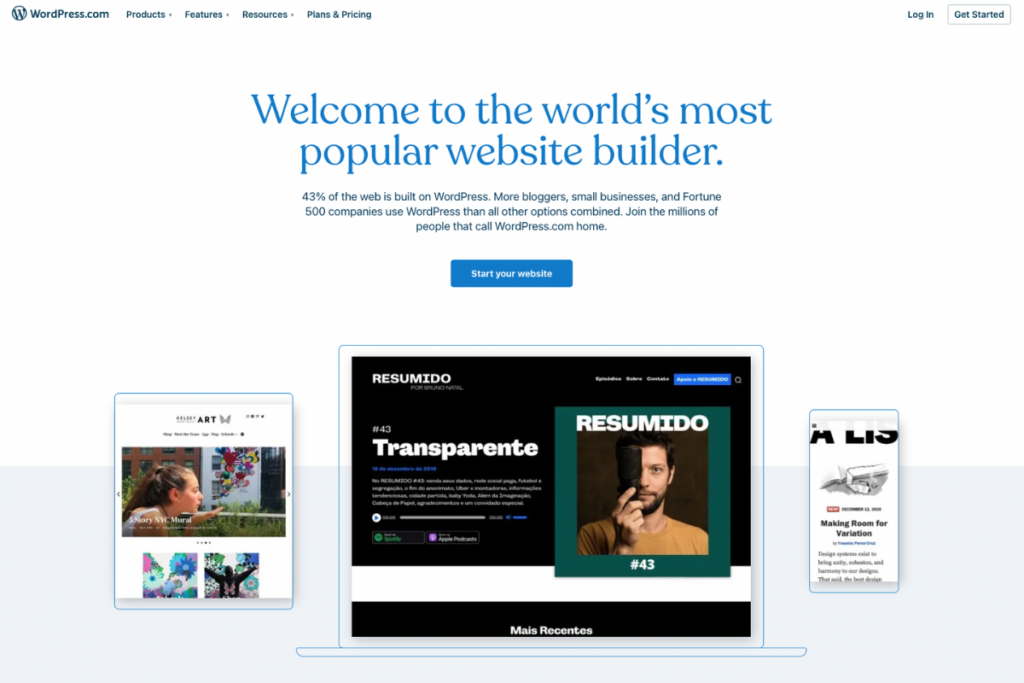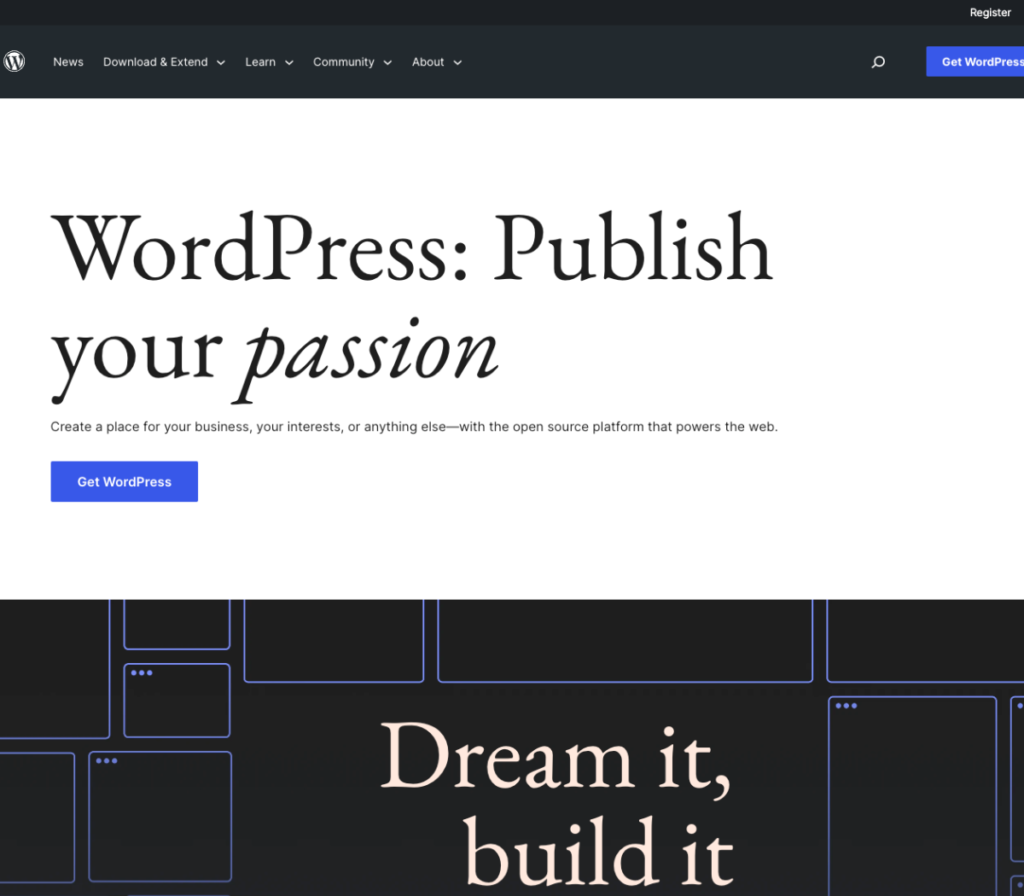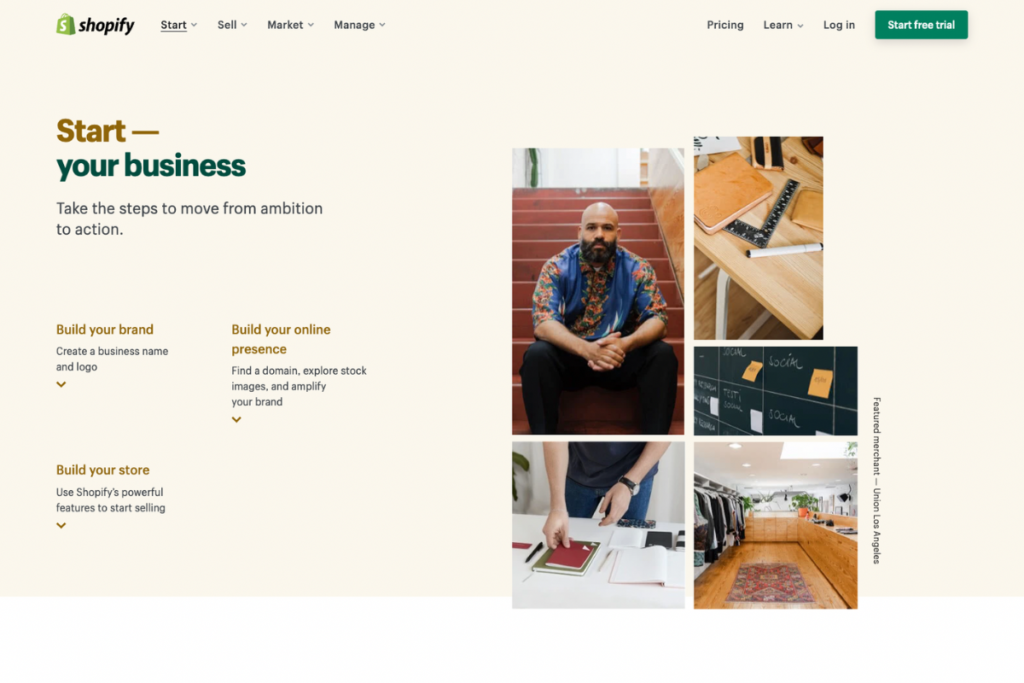These days, there’s no question that the customer journey primarily begins online—and often people start their journey by visiting your small business website. But how can you build the best website possible with the lowest financial investment and a minimal amount of stress without sacrificing customization?
Read on to learn which website builders can help you build a business website that will convert consistently—without breaking the bank.
Best Small Business Website Builders
To help you get started, here are four of our favorite small business website builders and the pros and cons of using each.

1- WordPress
To put it lightly, WordPress is popular. It’s used by over 43% of all websites on the internet. It’s important to note that WordPress isn’t a website builder—it requires additional plugins to include drag and drop builder functionality.
Let’s take a look at some of the pros and cons of this website powerhouse.
WordPress Pros:
- When it comes to flexibility and customization, WordPress can’t be beat.
- There are basically no limits to how many features and functionalities you can add to your website.
- WordPress allows you to use various third-party tools and plugins.
- Because you manage your own hosting, WordPress is highly autonomous—more so than almost any other website builder.
WordPress Cons:
- Because WordPress is a self-hosted platform, you definitely need technical knowledge and skill to utilize it.
- Managing your own hosting can be complex, especially when it comes to security, so you will need to brush up on your coding.
- WordPress is open-source, meaning no one owns it and there are no official WordPress customer service resources to provide help. (The good news is that you can often solve problems by asking a developer or relying on community advice—since there are so many WordPress users, there are lots of people and resources who can help you troubleshoot.)
How Much Does WordPress Cost?
WordPress is free—kind of. Instead of paying WordPress for your site, you pay a web hosting company like Bluehost or SiteGround to host the site. Hosting costs are very affordable, often under $3 per month.
2- Wix
If you’re looking to build a highly professional website, Wix is another incredible option. Wondering if this platform is right for you? Let’s talk about it.
Wix Pros:
- Wix’s trademark drag-and-drop editor is very simple to use, no matter your level of technical experience. So unlike WordPress, you don’t have to know any code to use Wix.
- Wix is very beginner-friendly and easily scalable.
- With Wix’s plethora of easy-to-use tools, you can customize your templates to look and function exactly how you want them to.
Wix Cons:
- With Wix, you don’t have the ability to swap your template once you’ve published your business website.
- Wix makes you pay to install apps from third parties, making some customization a bit more expensive.
How Much Does Wix Cost?
Wix pricing plans are very affordable. Personal plans start at $16 per month, and basic business plans start at $27 per month—a small price to pay for a website you can turn into a lead-generating machine.

3- Squarespace
Squarespace can help you create one of the most stunning small business websites on the internet. Let’s go over some pros and cons of this website builder.
Squarespace Pros:
- Squarespace has beautiful templates that are specifically optimized for tablets, desktops, and mobile devices.
- Squarespace offers top-of-the-line marketing features and world-class support for all clients. If you’re looking for a website builder that will give you a hand to hold throughout the entire process, Squarespace is it.
Squarespace Cons:
- Squarespace doesn’t offer as much customizability as Wix or WordPress. You can only customize within your template’s preset rows, which can be a major obstacle to getting the exact website that you want (especially if you’re hoping for something highly complex or unique).
How Much Does Squarespace Cost?
Squarespace pricing plans are pretty comparable—and even slightly cheaper in some cases—to those of Wix. Personal plans start at $16 per month and business plans start at just $23 per month.
4- Shopify
Shopify is another site builder that can totally up your game if you’re looking to build an online store with a significant number of built-in features and applications.
Shopify Pros:
- You don’t need any technical skills to utilize Shopify.
- Shopify makes it easy for you to sell across multiple channels.
- The Shopify team offers 24/7 customer support.
Shopify Cons:
- Because Shopify has fewer built-in features than other website builders, so you might need to rely on applications to make your website work exactly how you want it to.
- You’ll have to pay a high transaction fee if you opt for a payment platform other than Shopify Payments.
How Much Does Shopify Cost?
Shopify is definitely pricer than some other options, with basic plans starting at $29 per month, and more advanced plans costing as much as $299 per month. The good news? If you pay on a yearly basis, Shopify gives you a 50% discount.
Small Business Website FAQs
- What website builder should I use for my small business? There’s no one-size-fits all answer when it comes to a small business website. Different businesses have different needs. If you’re still not sure which builder is best for your business, we’d recommend analyzing your budget, making a list of your website must-haves, and figuring out who will be running your site and what their skillset looks like.
- How much does it cost to create a website for a small business? Small business websites are generally pretty affordable, and if you consider the potential impact they can have on your bottom line (did someone say lead generation?) the costs are well worth it. You can build a website yourself for as little as $100 or upwards of $5000. It all depends on your budget and your specific needs.
- How do I create a simple small business website?
- Get clear on your goals—what do you want your site to accomplish?
- Claim your domain name.
- Choose your web host and website builder.
- Start building your pages.
- Optimize your content for search engines.
- Experiment, learn, and watch your online presence grow.
- What is the best free website builder for small businesses? While you can technically start a website for free with services like Wix, GoDaddy, WordPress, and others, you’ll most likely want to pay for upgraded features or plans at some point. Just make sure to choose a builder that allows for scalability and flexibility as your business grows and evolves.
Small Business Website Best Practices
After you’ve chosen your website builder, it’s time to optimize. Here are the 10 most effective ways to increase targeted website traffic—and keep leads coming back for more.
- NAP. To direct traffic, you need your business to be at the top of the Google Map Pack. Google has a number of ranking factors, but a key one is keeping NAP (name, address, phone number) consistent across all of your directory listings.
- Reviews. On a local SEO level, small businesses have the advantage over national chains if they can consistently get new and authentic reviews. Having lots of reviews can take you to the top of the Google Map Pack, and a lack thereof can leave you completely undiscovered. 97% of people read reviews for local businesses before choosing to engage with them—give the people what they want: reviews.
- Rating. Quantity is great, but let’s not forget about quality. Did you know that most consumers won’t engage with a business that has a star rating below 3.3? If you want to get found, and more importantly convert, increasing your star rating is key. Tools like Podium can help you increase your number of reviews, and if you’re doing business right, this can lead to a bump in your star rating.
- Long-tail keywords. Long-tail keywords are highly specific search phrases that people use when searching for you on Google. Implementing these phrases in your content will bring your product or service to the top of the search results when someone is looking for what you sell. When creating content, make sure to also include popular keywords associated with your service or product, along with your local city or region.
- Irresistible headlines. Without a headline that hooks, even the best blog post will go unread. Your headline should be dynamic, concise, and irresistible. Take time to really work, and rework, your headlines to land on the ones that potential leads won’t be able to resist clicking on. You can even research which words and phrases tend to get the most clicks and capitalize on those trends. For example, people love a good how-to headline or a headline that includes numbers.
- Insatiable content. Your content should be so good that it’s almost addictive. If your content is high quality, leads will be more likely to share it, which means free marketing for you. Make sure your content is relevant and varied, appealing to all different sectors in your audience. Include short and long-form content, news-oriented and high-level pieces, and great graphs, images, graphics, and videos.
- Backlinks. Implementing quality backlinks is a great way to drive the right people to your website. Major search engines such as Google think of backlinks like “votes” for a specific page in their algorithm. This means that the more backlinks you have, the more likely your page will rank higher in terms of SEO.
- High-quality images. People love pictures. Google has found that listings with feature photos receive 42% more requests for driving directions from Google Maps and 35% more clicks to a website. That’s straight gold. Fill your website with high-quality, relevant, and appealing images. Each photo should load quickly and serve a clear purpose. And while we understand the convenience of stock images, keep in mind that people love to see real pictures of your employees and products in action.
- Live chat. Live chat is a feature that 41% of customers expect to see when they land on your website, and this kind of convenience pays. A recent survey reported that live chat leads to a 48% increase in revenue per chat hour and a 40% increase in conversion rate. And with a live chat feature that can seamlessly move from desktop to mobile interfaces and back like Podium’s Webchat, those percentages increase.
- Website responsiveness. Another major factor is how responsive your site is—whether it transitions easily to mobile interfaces is not only important to building a quality site but is also a major Google ranking factor. Furthermore, your website should be fast—each page should be technically optimized so that it will load as quickly as possible. Take stock of images and videos to ensure that they are optimized and not slowing your customers down.
Why Your Website Matters
Even if a website isn’t necessary for your business to operate (like it is for an online store) your potential customers and stakeholders still expect you to have one. A professional website demonstrates your credibility right off the bat by telling your audience that you’re serious. Without an online presence, consumers might not even consider your brand to be legitimate.
Shoppers see a company’s website as a crucial resource that can give them the answers they need to feel confident making a purchase. While they may want to learn about your trustworthiness and quality of work from their peers, they want information about your products and services, pricing structure, store hours, policies, and more straight from you. Unsurprisingly, not all of this info will fit on your social media pages—you have campaigns to run and engagement to drive, after all.
With a website, you can keep well-organized evergreen pages that your consumers can easily find without having to scroll through months of posts. On the flip side, if you don’t have a website, these same shoppers may choose to turn to your competitors.
Perhaps most importantly, a website is critical for any business that wants to reach any of the following sales and marketing goals faster:
- Capture and convert more leads: Contact forms and lead-capturing tools like Podium Webchat are easy to embed on websites. On the other hand, marketing channels like Facebook pages and LinkedIn pages may get many visitors who leave without even thinking of providing their contact information.
- Reach more potential customers: Focusing on search engine optimization (SEO) on your blog, web pages, or landing pages can help people find you when searching on Google.
- Get more insight into consumer behavior: Powerful analytics tools can be used in conjunction with any website, giving you insight into everything from page views and read-through rates to what shoppers are adding to their carts and purchasing.
- Build your brand: A website is one of the most effective tools for building your online presence and strengthening your brand identity. It tells new and existing customers everything they need to know about your brand and what it stands for, so they don’t need to hear it from anyone else.
Build Your Small Business Website
With the above tips and the right website builder in your toolkit, you’ll be able to build and optimize a site that converts so you can connect remotely, close deals, and keep customers coming back for life.
Building a small business website isn’t an exact science—but the good news is, you don’t have to get it perfect on the first go. Something is better than nothing, and with some tweaks and experimentation along the way, you’ll have a fantastic website that gives your customers the answers they need.





